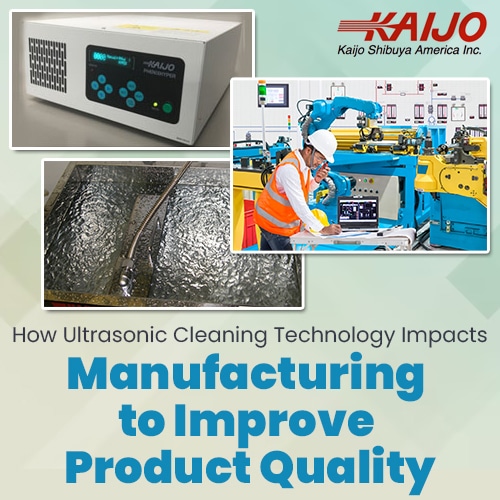How Ultrasonic Cleaning Technology Impacts Manufacturing to Improve Product Quality
August 16, 2023
 When improving output quality runs into cost and efficiency issues, ultrasonic cleaning technology can offer a solution. Removing contaminants from parts and components during manufacturing is costly and sometimes incomplete, but the cleanliness of these parts often impacts product quality. Ultrasonic cleaning removes contaminants quickly and completely, even from hard-to-reach places and rough surfaces. Operating costs are low, and the process is safe and environmentally friendly. Switching to industrial ultrasonic cleaners can reduce costs and speed up production while improving product quality.
When improving output quality runs into cost and efficiency issues, ultrasonic cleaning technology can offer a solution. Removing contaminants from parts and components during manufacturing is costly and sometimes incomplete, but the cleanliness of these parts often impacts product quality. Ultrasonic cleaning removes contaminants quickly and completely, even from hard-to-reach places and rough surfaces. Operating costs are low, and the process is safe and environmentally friendly. Switching to industrial ultrasonic cleaners can reduce costs and speed up production while improving product quality.
How Advanced Cleaning Technology Impacts Costs, Efficiency, and Product Quality
The cleanliness of parts at the end of a manufacturing process step is often critical for the successful completion of subsequent steps. Advanced cleaning technology is designed to ensure that the required degree of cleanliness is achieved.
Advanced cleaning technology using traditional methods such as scrubbing, soaking, and washing is expensive and inconsistent. Such methods often slow down the manufacturing process, and it isn’t easy to measure cleaning effectiveness. Traditional methods come with higher costs, lower efficiency, and uncertain improvements in product quality. What’s needed is an inexpensive advanced cleaning technology that cleans quickly and gives consistently excellent results.
How Ultrasonic Cleaners Reduce Costs and Improve Efficiency
Ultrasonic cleaning is an advanced technology that uses plain water to clean many parts and components quickly. It reduces operating costs by eliminating expensive chemicals and their storage, handling, and disposal. Ultrasonic cleaning technology supports lean manufacturing principles by speeding up production and reducing waste.
Ultrasonic cleaning works by producing microscopic cavitation bubbles in the cleaning tank. The bubbles deliver intense scrubbing action to dislodge contaminants. The process works quickly, and the parts come out of the tank completely clean. Ultrasonic cleaners can easily be integrated into a highly automated manufacturing line to give quick, inexpensive, consistent results.
How Ultrasonic Cleaning Impacts Product Quality
The cleanliness of parts used in manufacturing impacts output quality in many different manufacturing processes. In semiconductor manufacturing, the cleanliness of the silicon wafer is critical to reducing the failure rate of semiconductor products. Cleanliness in the food industry is a safety issue. Cleanliness in medical device manufacturing can impact patient health. As a result, cleaning technology is a major issue for many manufacturing engineers.
Ultrasonic cleaning is a solution to many of these concerns. Key requirements of a cleaning solution include cleaning effectiveness and consistency. When configured correctly, with the right frequency, power, and cleaning times, industrial ultrasonic cleaners consistently remove all traces of contamination. Product quality that is dependent on clean inputs will be consistently high.
How Manufacturing Challenges Can Be Addressed with Ultrasonic Cleaning
In addition to improving product quality while controlling costs, manufacturing line challenges include improving line efficiency and adopting new technologies. When identifying bottlenecks in the production line, the cleaning of parts is often a candidate. Switching to comparatively fast-acting ultrasonic cleaners will often eliminate such bottlenecks and make the line more efficient.
Adopting new technologies, including higher levels of automation, is often difficult when parts cleaning includes manual or dangerous procedures with toxic chemicals. Ultrasonic cleaning is completely safe and does not require monitoring. An automated system can place parts in the cleaning tank, switch on the system, and remove the clean parts after a set time. Information feedback on cleaning status, water use, and process times can be set up.
How Different Manufacturing Roles Can Influence the Decision to Use Ultrasonic Cleaning
Manufacturing operations include several roles that evaluate or impact product quality. Production managers see the whole process and are interested in product quality from a big-picture point of view. Operations managers want the line to run smoothly and efficiently. Quality assurance managers evaluate problems with product quality and trace them back to the source. All have an interest in product quality but from different viewpoints.
Ultrasonic cleaning technology can bring these viewpoints together to make decisions. The managers each have a certain amount of influence and must be able to see the advantages of ultrasonic cleaning from their point of view. Overall, from a production point of view, facility performance will improve. For operations, ultrasonic cleaning is easy to use, and operating the cleaners is problem-free. For quality assurance, product quality will be objectively better. A decision to use ultrasonic cleaning should normally receive broad support.
Kaijo Can Help Manufacturing Engineers Decide How to Use Ultrasonic Cleaning.
Kaijo works closely with customers to help them use ultrasonic cleaning technology to achieve manufacturing efficiency and operational excellence. In addition, Kaijo offers free consultation and a demonstration of using an ultrasonic cleaning system for your specific application. Contact Kaijo to discuss how ultrasonic cleaners can be used to solve the challenges of your industrial cleaning requirements.





